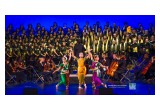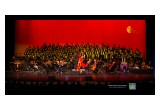"Shanti - a Journey of Peace," Mesmerizes the Bay Area; Ensemble of 150 Singers and Dancers in Indian and Western Traditions Perform a Stunning Clarion Call for Peace
San Francisco, CA, September 13, 2016 (Newswire.com) - First center in the U.S. for Dharma studies at the GTU in Berkeley to benefit from the October 1 concert in Oakland
In a tribute to the 5,000 year-old cultural history of India, “Shanti – A Journey of Peace,” tells a sweeping story through choral music, dance, and stunning and thought-provoking visuals. The show will be performed on October 1 at the Mormon Interstake Auditorium in Oakland. Proceeds will benefit the Hindu Studies program, housed by the first Center for Dharma studies in the U.S. at the Graduate Theological Union in Berkeley, California.
"I wanted to narrate the story of Indian culture in a powerful way, using large mixed choruses, Indian and western orchestral ensembles, and multi-genre dance
Kanniks Kannikeswaran, Composer, "Shanti -- A Journey of Peace"
http://www.dcfshanti.org/
Returning for its second showing after a successful performance in front of a packed audience of more than 2,000 at the Flint Center in Cupertino last May, “Shanti” features sacred lyrics in the ancient languages of Sanskrit, Tamil, and Pali. It is performed by a150-member choir, soloists, instrumentalists, and dancers – all held together by a gripping narrative.
“Shanti – A Journey of Peace,” the first oratorio of its kind, is the brainchild of Cincinnati-based composer Dr. Kanniks Kannikeswaran, a pioneer of the Indian American choral movement. Kanniks, who created this magnum opus in 2004, has brought this sacred experience to audiences in major cities for the past 12 years. He said, “’Shanti’ is more than a vocation, it is a calling.”
“Shanti—A Journey of Peace” is an extraordinary multimedia performance of music, dance, and images that captures the spirit of Universal Peace (shanti in Sanskrit). It brings the audience into the direct experience of shanti. “One cannot passively watch as it awakens the heart, stirs the soul, and illumines the mind with the call of the greatest vision of all time,” said Kanniks.
“Shanti” paints the story of Indian civilization on a very broad canvas and has had a very powerful impact on audiences. Shanti has been instrumental in the blossoming of Indian community choirs all around the country, leading to the first-ever Hindustani Choir of Surinamese Indian singers in The Netherlands. Shanti has been performed in Cincinnati, Houston, Atlanta, and Allentown, PA; and has led to the founding of Indian community choirs under the Kanniks’ leadership in places such as Chicago, Washington, DC, Tampa, Fort Lauderdale, and Dallas.
Backgrounder
A community of love created the Bay Area “Shanti” experience. Performers hail from different parts of the Bay Area -- including Santa Clara, Palo Alto, UCSF, Sunnyvale, Cupertino, Saratoga, Dublin, San Ramon, Oakland, and Modesto. Interviews are available upon request.
The composer, Kanniks Kannikeswaran
Kanniks’ work has touched, moved, and inspired over 2,000 artists that have worked closely with him over the past 12 years.
“I wanted to narrate the story of Indian culture in a powerful way, using large mixed choruses, Indian and western orchestral ensembles, and multi-genre dance,” he said.
Kanniks made several trips to the Bay Area starting in August 2015 to inspire the singers, teach the singers, and transform a group of singers into a choir with its own identity.
“My vision since 2004 is to build Indian community choirs in 100 cities in the United States and to make ‘Shanti’ a growing repertoire of raga-based choral music readily available to any community that desires to sing.”
View Kanniks on TedX in 2015 –https://www.youtube.com/watch?v=3dn8fsRTVXk
Listen to Kanniks’ NPR 2013 interview – http://www.npr.org/2013/11/07/243535684/across-america-voices-rise-to-reinvent-india
The Santa Clara Chorale Director Dr. Scot Hanna-Weir speaks on the wholly new and unique process of combing Indian traditional music with a Western choir.
Scot said, “East meets West is certainly a theme that has been explored a lot in contemporary music, but uniting an Indian choir and a Western choir is pretty unique. ‘Shanti’ is anything but your standard choral piece with orchestra. It is a magnificently vivid, colorful, lively, and thought-provoking piece. The Indian choir was so well-trained and ready to go on the music that it was really inspiring for the Western choir when we joined. There was also a great spirit of collaboration right from the beginning and throughout the whole process, and that always helps things to be successful.”
Scot and his choir joined rehearsals for “Shanti” in late March. The first performance was held in May at the Flint Center.
“Initially, the text was very difficult for me and the western choir. A lot of it is in Sanskrit, so at least the text was equally unfamiliar to all of us in the project. ’Shanti’ has had a long performance history, so the essential musical materials were all there and well-tested. Kanniks and I had a number of meetings to go through the score and parts, making sure that I understood the overall vision and structure.
“A production like ‘Shanti’ has so many moving parts that everyone needed to be on their game. It was easy for us to be enthusiastic about what the project could be and what the project was about. The Indian choir had been rehearsing already for a couple of months when the Santa Clara Chorale joined rehearsals, but the two ensembles were able to come together very quickly. Even though the singers came from very different musical traditions, the cohesive musical vision of Kanniks and the beautiful message of the piece united them. Also, the Indian dresses are quite complicated, so rehearsal was key to pulling off the splendid visual dance aspects.”
Graduate Theological Union (GTU) President Riess Potterveld
The GTU established this year for the first time in a major U.S. university a Center for Dharma studies. The GTU is the largest interreligious and interdisciplinary graduate education program in the country with over 300 students enrolled in masters and doctoral studies.
Dr. Potterveld said, “Societies and, as we all know, can be a source of conflict, and also of healing and reconciliation. The GTU has the chance to be the school with a complete table of representation of all the religious traditions of the world and then, together, we can focus on solutions to persistent and perplexing problems that continue to challenge us – climate change, environment, religious conflict, and status of women in the world. We work on many of these problems in the hope that we can contribute to solutions toward a more enduring peaceful and sustainable world. The arts are very closely woven into spiritual and religious practices, so it would follow that students and faculty have a deep interest in ritual and religious practice. ‘Shanti’ is a sacred experience; it represents the wonderful diverse cultures of the San Francisco Bay Area in fusion – all performing in the Auditorium of the Mormon Interstake Center in Oakland.”
http://gtu.edu/news/gtu-establishes-first-center-dharma-studies-us
###
Shanti Video – Testimonials:
https://www.youtube.com/watch?v=04rayCEDod4
Shanti Promo -- http://www.dcfshanti.org/
Contact:
Shirley Gines, sgines@firebrandglobal.com
858.395.0888 cel
www.dcfshanti.org
Source: Dharma Civilization Foundation

